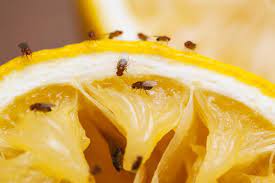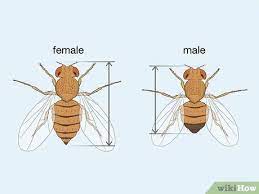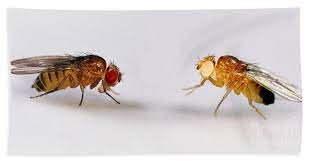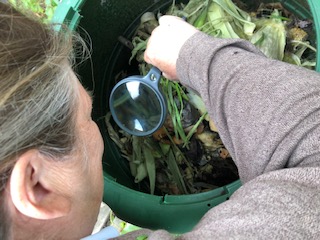The Nature of the Mundane. Part 2. Fruit Flies

It took me decades to make the connection between the annoying insects hovering above the fruit basket and Drosophila melanogaster, the inspiration behind six Nobel prizes over the past 100 years. They are one and the same.
I first heard about Drosophila in the context of genetics, some fifty-five years ago in high school. I imagined the bugs to be as big as my thumb nail or even my big toenail. How could something so insignificant and squishable, so negligible, be simultaneously celebrated as evolution’s great gift to basic science research?
In the early 1900s Thomas Hunt Morgan was looking for a model organism for his embryology research, something simple and easy to care for in his cramped lab. . Monkeys, chickens, and mice took up too much room and bred too slowly. Plus they smelled. Morgan was drawn to the attractive attributes of the fruit fly. They reproduce rapidly – the years required for vertebrate research can be condensed into months. Fruit flies’ dietary needs are simple, i.e., rotten bananas. They live in small odorless vials. Although small, they can be easily sorted using a dissecting microscope, the type used by high school students in their biology lab. Males have dark rounded genitalia and females have light pointed genitalia.

Mutations are easily identified based on such things as the shape and abundance of bristles, eye color and wing shape. The fruit fly offered everything Morgan needed.
I imagine Morgan in his lab, sifting through the thousands of flies he teased out of his vial onto a petri dish permeated with an anesthetizing gas. (Even the evolution of all these steps is remarkable to consider. Who makes it their life’s work to develop a reliable anesthesia for a fruit fly?) Morgan snacks on a banana, which would have been fly food in a few days. He startles, drops his banana. “Holy shit,” he thinks. “Look at that fly. All the others have red eyes. That eye is white.”

That observation might have been sloughed off by a less prepared mind, but it was Morgan’s AHA moment, one that pivoted his career from embryology to genetics. Morgan isolated that white-eyed fly, bred it (recall that it is easy to separate male and female fruit flies) and discovered that white eyes showed up in the next generation. They were inherited. And even more interesting, only males had white eyes (check out that rounded genitalia on the right), so the white eye was a sex-linked trait. From that modest beginning, Morgan established genetics as a modern science. He received the Nobel prize in 1933. (See appendix A for all fruit fly inspired Nobel prizes.)
Genetics exploded from there. Fruit flies conveniently only have four chromosomes which are vastly expanded in the salivary glands (a fruit fly has salivary glands in that tiny body?) Visible mutations, such as eye color or wing shape, could be tracked to a specific chromosome location based on alterations in its banding pattern. Morgain relied on infrequent spontaneous mutations, but his colleague Muller discovered that radiation reliably produced mutations, accelerating research. Muller received the Nobel Prize in 1946.
As proof that fly people are not all nerds sorting flies in a Petri dish, scientists came up with cute names for mutations. The Tin Man mutation, for example, resulted in a fly without a heart, the Ken and Barbie mutation resulted in an absence of external genitalia, similar to their namesake dolls. The annual fruit fly convention, in San Diego in 2022, could be a lot of fun.
The initial attributes that attracted Morgan at the beginning of the 20th century are now available to high school students. Flinn Sciences offers everything you need to set up a fruit fly lab. For the low price of $10, a school can receive a vial of fruit flies with a specific mutation, such as eye color. The Lull-a-Fly anesthesia kit, complete with a plastic container labeled “Morgue” is a bargain at $11.00. I called Flinn Sciences full of enthusiasm but was told that for safety reasons, they only sold their products to “certified schools.” They were unmoved by my claim that I was home schooling my 4-year-old grandson who is besotted with fruit flies.
I decided to vicariously share Morgan’s AHA moment; a packaged fruit fly kit would be too easy. Maybe I could use my magnifying glass to spot a white-eyed mutant in my compost bin. I saw fruit flies everywhere on the melon rind, on the corn silk, the rotten tomatoes. The opportunity was thrilling.

I plunged my head into the bin and felt the gentle brush of the fruit fly swarm. They didn’t bite, they seemed innocuous, assuming they weren’t attracted to the odor of my own over-ripened flesh. I quickly realized I needed a whiff of that Lulla-fly anesthesia if I wanted to spend quality time with the jittery flies.

Plan B involved a make-shift fruit fly lab in my kitchen. I put a splash of vinegar in a jar and stoppered the top with a funnel fashioned out of scrap paper (the first draft of this essay). The fruit flies would follow the tempting odor into the bottle, but once in, they either would either lack the desire to leave, or lack the smarts to find the exit through twould be a suitable work-around for anesthesia.

My trap showed initial promise. The flies hovered around the funnel, but few entered the bottle and the ones that did presumably experienced a rapturous death immersed in intoxicating vinegar – i.e., they all drowned. That was okay, dead flies suited my purpose since I had no desire to breed them. I poured the vinegar into a dish and moved in with my magnifying glass.
I saw no white eyed mutants, but that was a stretch goal. Morgan screened thousands before he found his first. But I did experience my own deeply satisfying AHA moment – I spotted the obvious pointed tail of the female and the rounded tail of the male.
The genitalia of fruit flies have inspired generations of “fly people.” I am pleased to join their ranks in celebrating Drosophila melanogaster as a model organism providing critical insights into human physiology. Sixty percent of our DNA is shared with the fruit fly and 75% of human genetic diseases have models in this humble creature. I thought of Jeffrey Hall, one of the recipients of the 2017 Nobel prize. When informed, he replied simply, “I’m very pleased for the fruit fly.”
——————————————————————————————————-
The missing words in the following poem are a set of anagrams (i.e., share letters such as spot, stop, pots, etc.) The number of asterisks indicates the number of letters. One missing word at the end of a line will rhyme with the preceding or following line, providing a good hint. Your job is to solve the missing words based on the above rules and the context of the poem. Scroll down to Appendix E for answers.

Thanks to Thomas Hunt Morgan who studied a petri dish full of anesthetized *****
And exulted when he realized that some males had atypical white eyes.
A less prepared mind might have brushed this off as a meaningless quirk,
But Morgan realized its importance; genetics became his ***** work.
Now, the ***** of Drosophila research are thick, wide, and deep.
Congratulations to six “fly labs,” the Nobel prize is theirs to keep.
——————————————————————————————————————–
Appendix A: Nobel Prize Recipients based on Fruit Fly Research
1933 Thomas Hunt Morgan used drosophila to uncover the role played by chromosomes in heredity
1946 Hermann Joseph Muller used X-ray irradiation to increase mutation rates in fruit flies
1995 Edward B Lewis, Christiane Nüsslein-Volhard, and Eric F Wieschaus used drosophila to understand genetic control of embryonic development
2004 Richard Axel concentrated on odor receptors and the organization of the olfactory system
2011 Jules A Hoffmann was given the award for his research on the activation of innate immunity
2017 Jeffrey C Hall, Michael Rosbash and Michael W Young won the prize for uncovering the molecular mechanisms that control circadian rhythms
Appendix B: Scientific Foundation of the Following Based on Fruit Fly Research
- Genes and chromosomes
- Regulation of gene activity
- Nature of mutations
- Dangers of irradiation
- Information processing
- Understanding of circadian rhythms
- Principles of embryonic development
- Biology of stem cells
Appendix C.
Follow this link to see the heartbeat of a fruit fly.
Appendix D. Sarah Palin’s monumental ignorance
In the 2008 presidential campaign Sarah Palin took issue with wasting federal research dollars on “pet” projects. She offered the following example in a campaign speech:
“You’ve heard about some of these pet projects, they really don’t make a whole lot of sense and sometimes these dollars go to projects that have little or nothing to do with the public good. Things like fruit fly research in Paris, France. I kid you not.”
Richard Wolffe, the senior White House correspondent for Newsweek commented:
“I’m going to be as restrained and measured as I possibly can about this. But this is the most mindless, ignorant, uninformed comment that we have seen from Governor Palin so far, and there’s been a lot of competition for that prize.”
The following link will take you to a video, if you have the stomach to watch her smug smirk as she disses fruit flies.
Appendix E. Answers to word game poem
flies, life’s files
Follow Liza Blue on:Share:
